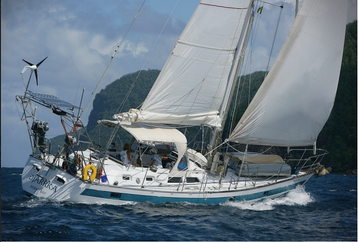
One of the new projects on the horizon for us is a citizen science initiative that will send mariners all over the globe recording audio data in the deep ocean. Each year, thousands of intrepid sailors and recreational boaters explore faraway islands, transit long coastlines, and cross oceans. Cruising sailors typically have rigorous knowledge of the ocean, electronics, and mechanical systems. They are ideal collaborators for citizen science.
We will be working with Ocean Conservation Research, Hello Ocean, and several large NGO and government partners to collect, analyze, and map data on human caused noise at sea. We will listen to things like offshore drilling, underwater mining, naval testing, shipping traffic, and seismic exploration. These extremely loud sounds can have long-term consequences for the well-being of dolphins, whales, and other marine mammals, disrupting behaviors that are crucial to their survival. Our target is to provide meaningful data that can be used to increase our understanding of the problem and help government and industry reduce these impacts, particularly during migration and mating seasons.
Silverleaf Geospatial is a leader in the technical implementation of mapping resources. This includes interactive web maps that receive live data from sailors as they gather audio, photo, video, and observational data. It also includes time lapse animations of observed sound propagation through the water, and interactive mashups of modeled and observed noise data. Silverleaf will also handle integrating external data sources like shipping traffic by using Automatic Identification System, or AIS data. Weather and sea-state data will also be integrated, as well as existing research from NOAA, and other partner organizations.
Silverleaf also provides support for data collection systems. While the bio-acousticians at Ocean Conservation Research will oversee the technical specifications of hydrophones and data collection hardware, we provide feedback and collaboration on field data collection technology, including mobile applications and offline data collection and syncing options.
We will be working with Ocean Conservation Research, Hello Ocean, and several large NGO and government partners to collect, analyze, and map data on human caused noise at sea. We will listen to things like offshore drilling, underwater mining, naval testing, shipping traffic, and seismic exploration. These extremely loud sounds can have long-term consequences for the well-being of dolphins, whales, and other marine mammals, disrupting behaviors that are crucial to their survival. Our target is to provide meaningful data that can be used to increase our understanding of the problem and help government and industry reduce these impacts, particularly during migration and mating seasons.
Silverleaf Geospatial is a leader in the technical implementation of mapping resources. This includes interactive web maps that receive live data from sailors as they gather audio, photo, video, and observational data. It also includes time lapse animations of observed sound propagation through the water, and interactive mashups of modeled and observed noise data. Silverleaf will also handle integrating external data sources like shipping traffic by using Automatic Identification System, or AIS data. Weather and sea-state data will also be integrated, as well as existing research from NOAA, and other partner organizations.
Silverleaf also provides support for data collection systems. While the bio-acousticians at Ocean Conservation Research will oversee the technical specifications of hydrophones and data collection hardware, we provide feedback and collaboration on field data collection technology, including mobile applications and offline data collection and syncing options.